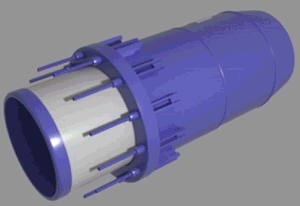

A telescopic joint between two pipes. Compression generates friction forces acting in opposite directions on left and right pipes. Pressure thrust force tends to separate pipes. Joint remains stationary when compression force is less than friction force. Sliding occurs when compression exceeds friction.


View expansion joint analysis results in Expansion Joint Deformation Table. See also How to Reduce Nozzle Loads in PASS/START-PROF.
Select expansion joint properties from the expansion joints database by clicking "..." and choosing the appropriate joint.
For slip type expansion joints, effective area Aeff = π × (ID)² / 4, where ID is internal pipe diameter.

Property |
Description |
Name |
Element name. Check to display in 3D view. |
Allowable Axial Expansion Movement, Δk |
Maximum allowable linear deformation: Δk/2, where Δk is full allowable axial movement. Used for expansion joint deformation analysis. Obtain value from manufacturer. |
Frictional Force |
Maximum frictional force for slip type expansion joints. |
Pressure Balanced |
Enable to exclude pressure thrust force from analysis. |
Select the desired node, then use: Insert > Expansion Joint > Axial Slip Joint